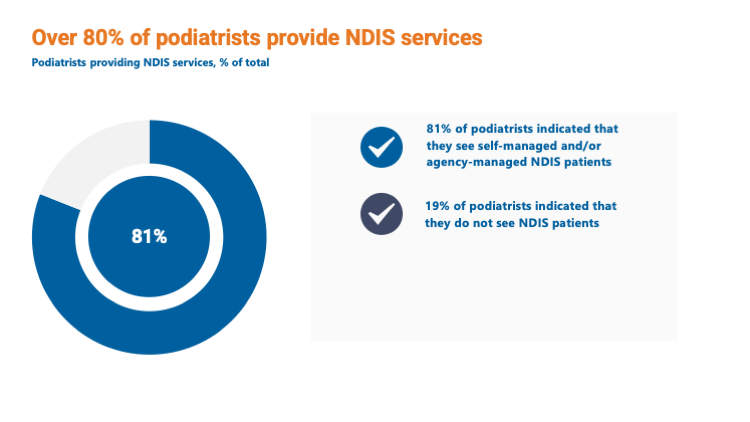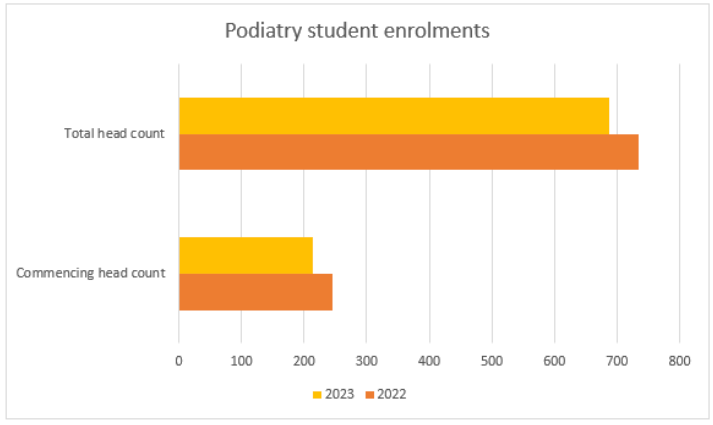2024 Podiatry Workforce Snapshot
12 months on from the APodA’s Workforce Summit
In early 2022, driven by growing concerns among its members, the Australian Podiatry Association (APodA) took the proactive step to organise and host APodA's National Podiatry Workforce Summit.
This pivotal event brought together nearly 20 influential figures from various sectors, including podiatry, allied health, and government agencies. Attendees included representatives from the Federal Department of Health, state-based Chief Allied Health Officers, the Australasian Council of Podiatric Deans (ACPD), stakeholders from the podiatry business community, and voices from rural, remote, and regional podiatry practitioners. Alongside these diverse participants were prominent policy and advocacy leaders, who all convened at the Summit with the purpose of deliberation and collaboration.
The APodA recognised that the Summit's primary objective was not to generate immediate solutions to the workforce challenges faced by the profession. Instead, its mission was to establish a platform for strategic knowledge exchange; aiming to unveil the complex and sometimes conflicting data that underlie the workforce issues at hand. As we reflect on the time that has passed since the Summit's inception, we take this opportunity not only to revisit the motivations that brought critical industry stakeholders together but also to gain insights into the direction in which our workforce is evolving.
2022 APodA’s Workforce Summit Results
At the conclusion of the inaugural Podiatry Workforce Summit, the APodA invited both attendees and the wider podiatry community to participate in a survey. This survey presented a significant opportunity for every Australian podiatrist to share their thoughts and ideas.
The profession has identified the top three issues as retention, undergraduate numbers, and recruitment. As we delve deeper into this report, we will see that university enrolment figures continue to be a significant concern. However, it's worth noting that the primary emphasis on the top two issues, retention and recruitment, appears to be driven by a perspective centred on business operations and sustainability. In understanding this viewpoint, there is an opportunity to explore how businesses and individual practitioners can exert influence downstream.
As we delve into the themes emerging from the survey, a collective focus area becomes evident. What stands out is that the perceived impact on the profession appears to originate upstream; involving entities such as the government, regulators, collegiate university deans, and the peak body. When we consider the spheres of influence, it becomes clear that most respondents envision change happening upstream, within the realms of authority, rather than downstream, at the business and individual practitioner levels.
It underscores the need for a comprehensive understanding of the levers that influence both upstream and downstream policies and effective measures, to determine where fundamental differences can be made.
The below rich picture, provided courtesy of the Podiatry Board of Australia, offers insight into the intricate web of relationships among various entities within the field of podiatry in Australia. It includes educators, regulatory bodies, government departments, the profession's peak body, private healthcare funders, and consumers. To effectively identify points of intervention for change, it is crucial to comprehend the distinct roles played by these key stakeholders.

In essence, the illustration underscores the importance of recognising the intricate dynamics and functions of these stakeholders, in the context of the podiatry profession in Australia.
The insights gathered from the APodA's Workforce Summit survey offer a valuable perspective on how the profession perceives its primary challenges and how these challenges manifest at different levels. What becomes evident is the profession's recognition of the critical role that advocacy and the dissemination of data play in shaping its future, both in the eyes of the public and within the profession itself.
Among the key takeaways from these responses is the growing pressure that businesses face in their efforts to attract and retain talent. Simultaneously, existing funding schemes need help to adequately support practices operating at the forefront of their scope and the establishment of robust clinician networks and professions.

The profession has identified the top three issues as retention, undergraduate numbers, and recruitment. As we delve deeper into this report, we will see that university enrolment figures continue to be a significant concern.
However, it's worth noting that the primary emphasis on the top two issues, retention and recruitment, appears to be driven by a perspective centred on business operations and sustainability. Understanding this viewpoint, there is an opportunity to explore how businesses and individual practitioners can exert influence downstream.

As we delve into the themes emerging from the Workforce Survey, a collective focus area becomes evident.
What stands out is that the perceived impact on the profession appears to originate upstream, involving entities such as the government, regulators, collegiate university deans, and the peak body. When we consider the spheres of influence, it becomes clear that most respondents envision change happening upstream, within the realms of authority, rather than downstream, at the business and individual practitioner levels.

It underscores the need for a comprehensive understanding of the levers influencing both upstream and downstream policies and effective measures to determine where fundamental differences can be made.
In sum, the survey responses paint a complex picture of the profession's challenges and opportunities, emphasising the need for a holistic approach that considers the interplay between advocacy, funding, and the individual practitioner's role in shaping the future of podiatry.
Podiatry’s Footprint
Podiatry general registration (PBA data) 10 years
Taking a broader view by examining the registration data provided by the Podiatry Board of Australia over 10 years, we observe a consistent pattern of expansion. This expansion aligns with the government's perspective.

To delve deeper, let's shift our focus to analyse the rate of this growth in percentage terms. What becomes immediately evident is that since 2014, the growth of Australia's podiatry profession has been on a significant decline. However, a different perspective emerges when we analyse the rate of growth in relation to total registrations over a specific period.

Total podiatry growth vs national population growth from 2013 to 2023 (%)

What becomes immediately evident is that since 2014, the growth of Australia's podiatry profession has been on a significant decline. However, a different perspective emerges when we analyse the rate of growth in relation to total registrations over a specific period.
By analysing data from the Australian Bureau of Statistics and the Podiatry Board of Australia, we gain insight into the growth trends of Australia's population compared to the growth of the podiatry profession within the country.
This data graphically illustrates a consistent decline in growth rates since 2013, both in the overall population and, notably, in the number of registered podiatrists. However, this graph alone doesn't capture the full impact of our aging population and the dynamics of supply and demand within the podiatry profession.
It's important to recognise that population changes aren't uniform across regions; necessitating a closer examination at meso (intermediate) and micro (individual) levels. This deeper analysis can provide a more detailed understanding of how these demographic shifts affect communities and how they evolve over time.
Distribution of podiatrists and other health professions

The Modified Monash Model (MM1) is an Australian classification system designed to categorise various geographical areas based on their degree of remoteness and the availability of healthcare services.
The graph above offers an overview of how practitioners are distributed across the Modified Monash Model zones. Apart from Aboriginal and Torres Strait Islander (ATSI) health practitioners, we can observe a relatively consistent distribution pattern, with MM1 retaining a significant share of the workforce.
Approximately 6% of the Australian podiatry workforce is located in outer regional or remote settings [8], with an estimated 16 podiatrists per 100,000 in major cities, and 6 to 10 podiatrists per 100,000 in outer regional or remote settings.
Disability and the Podiatry Workforce
Delivering disability support and care within the community is of utmost importance, and the role played by podiatrists is indispensable. However, the involvement of podiatry in this sector has often lacked clarity, not because of a lack of effort, but due to the intricacies involved in navigating various aspects.

In the past two years, APodA has undertaken efforts better to understand the role of podiatrists in this domain. Through various channels, and based on our membership data, we estimate that approximately 25% of podiatrists are registered with the NDIS. Furthermore, just under 70% of our members have indicated that they provide services to self-managed and/or agency-managed NDIS participants. In comparison, about 15% of members mentioned that they do not serve any NDIS participants.
The intricacies involved in gathering and analysing data of this nature provides us with a broad perspective of how podiatry interacts with the NDIS. It's important to note that further efforts are needed to enhance data collection and analysis rigour. However, some insights can be gleaned from the data collected from APodA members and the sentiment within the membership.

The accompanying pie chart sheds light on the uneven distribution of NDIS-registered podiatry providers. While it provides a general overview of the distribution of podiatrists registered with the NDIS, it doesn't give us a clear picture of demand. Understanding demand relies on data from the NDIA. Still, due to the limited availability of profession-specific usage data, this information remains a complex and elusive dataset, even though it is greatly needed.
Aged Care
Podiatry plays a pivotal role in providing support and care for our elderly population. However, comprehending the specific intersections of podiatry within this field is challenging due to various clinical settings and funding mechanisms.
With the assistance of the annual APodA membership survey, we have begun to paint a broader picture that contributes to a better understanding of podiatrists' roles and practices in this context.

Recognising the significance of grasping how and where podiatrists operate in support of the elderly has become increasingly important, especially considering the Royal Commission into Aged Care Quality and Safety, and the dynamic changes occurring in the aged care sector.
As we embark on this exploratory phase, in utilising our membership survey we aim to gain a deeper understanding of the distribution of podiatrists involved in providing support to individuals with home care package funding. We also aim to better understand the distribution of podiatrists working within residential aged care facilities.
The data obtained from the APodA's membership survey indicates an uneven distribution of podiatrists providing services to individuals with Home Care Packages across different states.

This data collection serves a dual objective. It enriches our understanding of APodA's membership composition and enables us to closely monitor and respond to significant developments in policies and legislation that impact these specific areas.
Similar to the findings in the APodA's Membership Home Care Package Survey question, there is an indication that the distribution of podiatrists providing care and services within aged care varies among states. Nevertheless, what is clear is that the most significant reform changes, slated for the end of 2023, are centred around aged care.
Gaining a better understanding of the distribution of podiatry services within this context may provide a valuable entry point to advocate for podiatrists' rights as the government advances this narrative.
Business – employment distribution
As with any profession, podiatry comprises various essential components. These components are instrumental in understanding the industry's workforce challenges and guiding the advocacy efforts of the profession's peak body.
The recent APodA membership survey creates a snapshot that provides insights into the predominant segments within the profession.
The pie chart presented below provides a visual representation of the employment composition within the field of podiatry:

Upon observing the pie chart provided above, it's evident that the data provides a preliminary overview. Still, more extensive analysis is necessary to achieve greater transparency and insights into the distribution of employment within the profession. What stands out is that, based on the available data, the two largest categories are self-employed/sole traders at 35% and employees at 37%. The remaining two categories, blank (or undisclosed) and employers, are evenly split at 15% each.
In a broad comparison with other allied health professions in Australia, it becomes apparent that, based on this data, podiatry has a higher proportion of self-employed individuals, sole traders, and employers. Understanding the implications of this and how it might impact the broader profession is of paramount importance.
The Future of The Workforce
Podiatry student enrolments in Australia and New Zealand
Data from multiple Australian universities offering Podiatry programs has been compiled to provide a comprehensive overview of student enrolments. This includes participation from various institutions across the country, reflecting the diverse landscape of Podiatry education. Our continued collaboration with the Australasian College of Podiatry Deans is instrumental in shaping this ongoing narrative, emphasising the significance of sustained partnership in driving excellence in Podiatry education and practice.

Commencing and total podiatry student enrolments in 2022 and 2023 (post-census, session one).

Podiatry – Towards a Sustainable Future


The APodA has developed a career framework for the practice and development of podiatry in Australia. The purpose is to provide a clear and uniform career progression beyond initial training. The aim is to develop credential competencies and clinical skills.
In awarding the credential, the APodA can verify that podiatrists have demonstrated and provided evidence of competency in their clinical interest area and have undergone a rigorous assessment process. The APodA awards credentials in the clinical interest areas of Paediatrics and Sports/Biomechanics, the Sports/Biomechanics framework developed in partnership with SEPA.
University Snapshot - Promoting podiatry programs and increasing enrolments
The University Snapshot provides insights into the strategies employed by institutions to promote Podiatry programs and drive enrolment growth. These efforts include hosting open days with interactive sessions, engaging in community events and career expos, and offering innovative programs such as certificates in foot health. Additionally, universities conduct workshops for high school students to showcase the profession's scope and impact, fostering interest in Podiatry education. These initiatives underscore a collective commitment to expanding awareness and opportunities in the Podiatry field.
This is an organic chart and will be periodically updated over time.
| Institution | Activity to promote podiatry program and increase enrolments |
|---|---|
Auckland University of Technology |
Each year the University hosts an open day (https://www.aut.ac.nz/live). This involves trade stands promoting podiatry, presentations to prospective students and clinic tours. |
Central Queensland University |
At CQ University, we are driven to ‘train locally to serve our local community’. Central Queensland has a large and growing population, and a high demand for Podiatry services. Our highly engaged Podiatry team have been working alongside our University’s marketing team as well as large and small community organisations to promote our Course and the Podiatry profession. We have been active in attending large careers expo’s, community sporting events (such as the Rockhampton River Run and the Yeppoon Running Festival), and high school presentations, as well as working closely with local Podiatrists to promote our wonderful and important profession. |
Charles Sturt University |
Charles Sturt University will offer a new Undergraduate Certificate in Foot Health in 2024. This UG Certificate is designed to provide students with foundational knowledge relevant to a podiatry assistant role. Students will study part-time for one year, completing two podiatry subjects and two anatomy subjects. The course will be offered in a blended mode enabling students to study online and attend four on-campus intensives to participate in practical classes and also work in the university clinic, under the supervision of experienced podiatry educators. A student wishing to progress to the B Podiatric Medicine will receive credit for subjects completed in the UG Certificate. |
La Trobe University |
Throughout 2022 and 2023, our main marketing endeavour revolved around conducting podiatry workshops for high school students at the La Trobe University Melbourne Campus. Our primary objective was to showcase the extensive scope of podiatry and highlight the positive impact that podiatrists have on their communities. We successfully organized over 40 workshops, primarily targeting local schools, while also reaching out to a few international ones. The participants, mostly from year 10, but with a range from years 8 to 11, benefited from interactive sessions that provided insights into working in healthcare and podiatry. During these workshops, students had the opportunity to participate in hands-on activities, including musculoskeletal ultrasound, doppler vascular assessments, and foot and ankle rehabilitation exercises. |
Monash University
|
D Podiatric commenced in 2023. University-led marketing webinars and Open Days. Promotional video scheduled for Sept 2023.
|
Queensland University of Technology
|
QUT linked with industry partners to showcase 3D printing technology, at the 2023 Open day. In addition to QUT academic staff and existing students being present on the day, this collaboration supported a team of QUT alumni, from varying stages of their career to be available to speak to any prospective students and describe the diverse nature of scope of podiatry. Linking with industry enabled the team at QUT to have a vibrant activity tent, with the 3D printer working throughout the day to print devices, this attracted a lot of interest from visitors to the open day and changed the nature of conversations we had about the profession of podiatry with potential future students and their families. This collaborative approach to try and grow demand for places in podiatry programs was well received by the Senior University leadership team and has been promoted through social media channels.
|
Western Sydney University
|
TBC
|
University of Newcastle
|
The Podiatry team at the University of Newcastle has been actively promoting the profession by involving the media and presenting at several health expos. We have participated in the yearly University open days (Central Coast and Newcastle), Children University Campus Discovery Days, Emerging days for first nation prospective students, and NAIDOC week. In July, we also ran a large Podiatry Expo for students, which was attended by Podiatry Alumni and local clinicians. At this event, we held different presentations from the Australia Podiatry Association, 3-minute pitches (3MP) from the largest Podiatry distributors in the country, and a panel of experts discussing the future of podiatry. The event was very well received by the delegates (58% students, 21% alumni, and 21% industry), reflected in a 4.83/5 satisfaction rate. It was a wonderful opportunity for our students to engage with multiple stakeholders, learn about the latest Podiatric Innovations, and discover more about the Endorsed Schedule medicine program. We are committed to maintaining strong engagement with our local health districts' Podiatry providers (Hunter New England and Central Coast). UON Podiatry staff have been helping with different CPD and workshop sessions on how to use some of the latest evidence-based technology that we have recently introduced as part of our clinical teaching. Finally, we have established new international student clinical placement exchanges with Spain and the UK. As part of the 'Colombo Mobility Plan', in Jan & Feb 2024, we have selected a group of UON Podiatry students who will be traveling to the Philippines to provide free Podiatric Care to the local community. |
University of South Australia
|
TBA |
University of Western Australia
|
TBA |
Where to next? Thoughts from A/Prof Caroline Robinson
APodA 2023 Podiatry Workforce Snapshot
Opinion piece written by A/Prof Caroline Robinson
Podiatry has always had an image issue. Even back in 1979 when I enrolled at the Chelsea School of Chiropody in London, my family, friends and strangers were all puzzled by my choice of career path. However, student enrolments were high and recruitment to podiatry programs was not a major concern for institutions. Sadly, what we have witnessed in Australia since 2015 is a steady decline in podiatry student enrolments. This is a broader issue affecting New Zealand, the UK and US but my focus in this piece is on the Australian problem.
Podiatry programs have come under increasing scrutiny from the university executive as small courses are loss-makers for an institution and podiatry is an expensive clinical course. Podiatry programs can become locked into a downward spiral as a university invests in courses which recruit well such as occupational therapy, physiotherapy, and speech pathology. A few non-podiatry champions do stand with podiatry academics and advocate but our profession is small in comparison to physiotherapy and occupational therapy, and we lack political power. The community may complain loudly about a prospective course closure but we need a far stronger and powerful collective voice to ensure state and federal governments understand the true cost of reducing the podiatry graduate pipeline, decimating podiatry services and ultimately compromising the future of the podiatry profession.
This collective voice has been absent or at best, poorly coordinated. All stakeholders need to accept the challenge to reverse the trend and increase podiatry student enrolments.
University course teams must engage with community and industry partners to design podiatry programs which are accessible to prospective students at different life stages, with diverse needs. If we are to succeed in increasing podiatry student enrolments, we cannot expect people with family and work commitments to re-locate to another part of the country for study or rely on the finite pool of high school students who typically consider feet to be gross!
University marketing teams focus on selling the ‘brand’ and it’s left to the small teams of podiatry academic and clinical staff to promote our programs. But it’s no use leaving it up to high school students to select the ‘podiatry’ session when they have no knowledge of what a podiatrist does, or the career pathways available to them. Educating school careers advisors and teachers about podiatry is worthwhile effort but this can be undone easily if a student’s family or friends convince them to choose another pathway.
All podiatrists have the opportunity each day to challenge those who perpetuate the stereotype of podiatry as ‘foot care’. Practitioners also have a responsibility to maintain professional development and work to full scope of practice. If a simple footcare service is all that some podiatrists are content to provide, it’s no wonder some doctors, nurses, other allied health professionals and clients continue to hold outdated beliefs and share misinformation about podiatry practice.
The Australian Podiatry Association (APodA) as the national peak body for podiatry has a major responsibility for advocacy and marketing the profession. A past reliance on marketing resources which exacerbated the image problem rather than challenging community perceptions of podiatry, did not assist universities to promote podiatry as an exciting and rewarding career pathway.
Since 2022, collaboration of the APodA with the Australasian Council of Podiatry Deans (ACPD) has generated energy for a renewed focus on the podiatry ‘brand’. However, much greater investment is required to understand the needs of prospective students and promote podiatry as an aspirational career. We need to create a cultural change across the profession to restore pride in the full potential of our discipline. If we lose focus on sustaining and growing the number of podiatrists in Australia, we will witness an increasing erosion of our practice by other disciplines such as physiotherapists, clinical exercise physiologists, occupational therapists and nurses.
As a podiatry educator, I am immensely proud of all our graduates who enter the workforce with capabilities and knowledge which might challenge podiatry practitioners who have years of experience. We must all take responsibility for nurturing these new members of our profession, to learn from and with them and provide them with opportunities for working to full scope of practice. These novice practitioners are not a threat, they are our future and we need more of them


